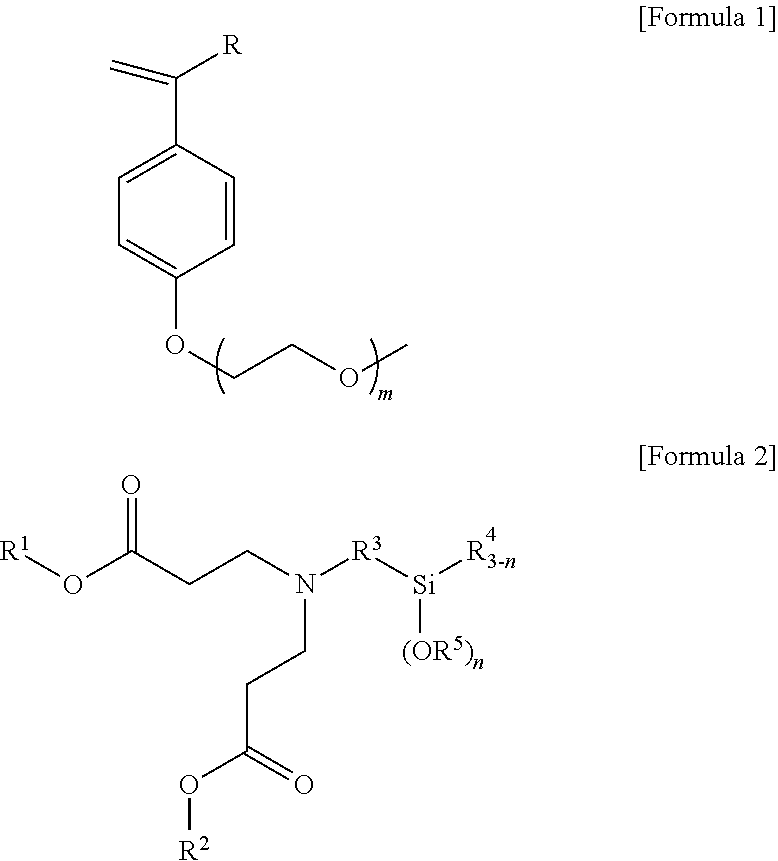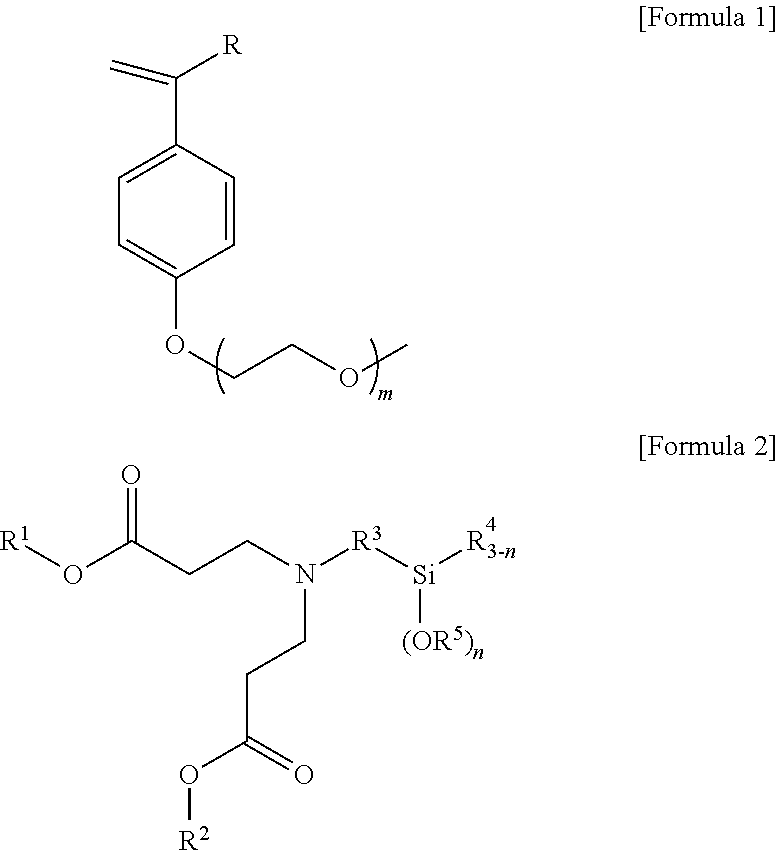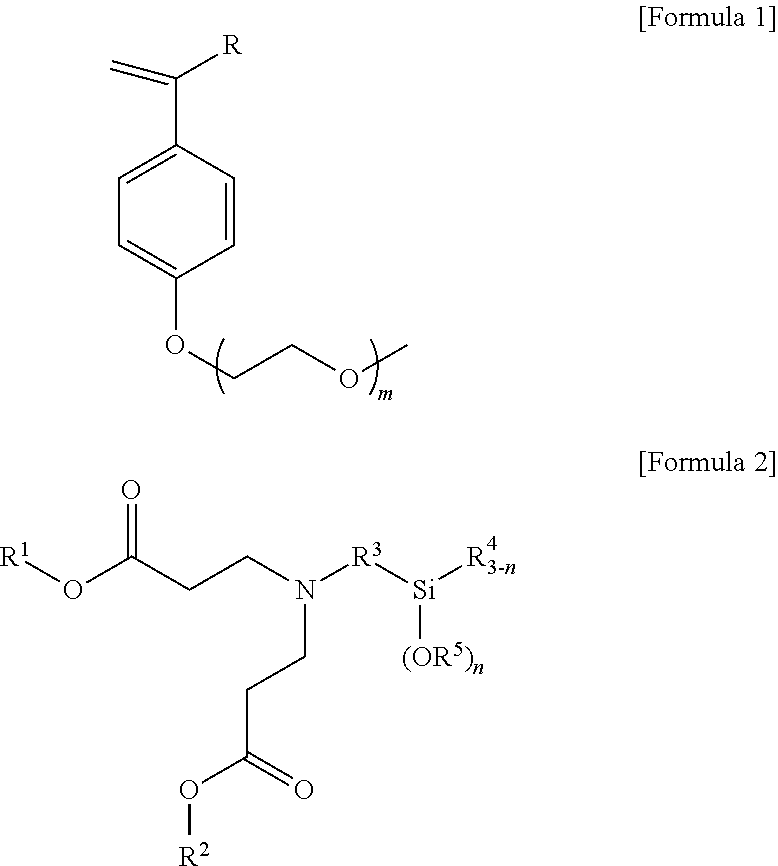Modified polymer, method of preparing the same, and rubber composition including the modified polymer
a technology of modified polymers and polymers, which is applied in the field of modified polymers, methods of preparing the same, and rubber compositions including modified polymers, can solve the problems of low wet skid resistance of rubber and insufficient effect, and achieves low modification ratio, reduced use of polar solvents, and easy introduction.
- Summary
- Abstract
- Description
- Claims
- Application Information
AI Technical Summary
Benefits of technology
Problems solved by technology
Method used
Image
Examples
preparation example 1
ethoxyethoxy)-4-vinylbenzene
(1) Preparation of Hydroxystyrene
[0129]0.275 mol of sodium hydroxide was put in a 500 ml round-bottom flask and dissolved by adding 60 ml of anhydrous ethanol thereto, and 0.065 mol of acetoxystyrene was then added thereto and stirred for 4 hours in a nitrogen atmosphere at room temperature. Thereafter, 50 ml of distilled water was added and 30 ml of acetyl acetate was added to extract an organic layer, and the organic layer extraction was repeated three times. Anhydrous magnesium sulfate was added to dry and filter the extracted organic layer so that remaining moisture was removed. Thereafter, the solvent was removed under reduced pressure to obtain 7.54 g (96% yield) of yellow solid hydroxystyrene. 1H nuclear magnetic resonance spectroscopic data of the purified hydroxystyrene are as follows.
[0130]1H-NMR (500 MHz, CDCl3) δ 7.31-7.29 (d, J=9.5, 1H), δ 6.80-6.78 (d, J=8.5, Ar—H, 2H), δ 6.68-6.62 (q, J=9.5, 1H), δ 5.62-5.58 (d, J=17.5, 1H), δ 5.13-5.11 (d,...
preparation example 2
2-methoxyethoxy)ethoxy)-4-vinylbenzene
(1) Preparation of Hydroxystyrene
[0133]0.275 mol of sodium hydroxide was put in a 500 ml round-bottom flask and dissolved by adding 60 ml of anhydrous ethanol thereto, and 0.065 mol of acetoxystyrene was then added thereto and stirred for 4 hours in a nitrogen atmosphere at room temperature. Thereafter, 50 ml of distilled water was added and 30 ml of acetyl acetate was added to extract an organic layer, and the organic layer extraction was repeated three times. Anhydrous magnesium sulfate was added to dry and filter the extracted organic layer so that remaining moisture was removed. Thereafter, the solvent was removed under reduced pressure to obtain 7.54 g (96% yield) of yellow solid hydroxystyrene. 1H nuclear magnetic resonance spectroscopic data of the purified hydroxystyrene are as follows.
[0134]1H-NMR (500 MHz, CDCl3) δ 7.31-7.29 (d, J=9.5, 1H), δ 6.80-6.78 (d, J=8.5, Ar—H, 2H), δ 6.68-6.62 (q, J=9.5, 1H), δ 5.62-5.58 (d, J=17.5, 1H), δ 5.1...
preparation example 3
l 3,3′-((3-(triethoxysilyl)propyl)azanediyl)dipropionate
[0137]23.26 mmol of (3-aminopropyl)triethoxysilane was put in a 50 ml round-bottom flask and dissolved by adding 10 ml of ethanol thereto, and 46.53 mmol of ethyl acrylate was then added thereto and stirred for 24 hours in a nitrogen atmosphere at 80° C. to perform a reaction. After the completion of the reaction, the solvent was removed under reduced pressure, and distillation under reduced pressure was then performed at 80° C. to obtain 22.36 mmol (96.1% yield) of diethyl 3,3′-((3-(triethoxysilyl)propyl)azanediyl)dipropionate of Formula (iii). 1H nuclear magnetic resonance spectroscopic data of the purified 3,3′-((3-(triethoxysilyl)propyl)azanediyl)dipropionate are as follows.
[0138]1H-NMR (500 MHz, CDCl3) δ 4.07-4.03 (m, 4H), δ 3.77-3.72 (m, 6H), δ2.72-2.69 (t, 4H), δ 1.49-1.43 (m, 2H), δ 1.20-1.14 (m, 15H), δ 0.52-0.49 (t, 2H)
PUM
| Property | Measurement | Unit |
|---|---|---|
| wt % | aaaaa | aaaaa |
| molecular weight distribution | aaaaa | aaaaa |
| wt % | aaaaa | aaaaa |
Abstract
Description
Claims
Application Information
 Login to View More
Login to View More - R&D
- Intellectual Property
- Life Sciences
- Materials
- Tech Scout
- Unparalleled Data Quality
- Higher Quality Content
- 60% Fewer Hallucinations
Browse by: Latest US Patents, China's latest patents, Technical Efficacy Thesaurus, Application Domain, Technology Topic, Popular Technical Reports.
© 2025 PatSnap. All rights reserved.Legal|Privacy policy|Modern Slavery Act Transparency Statement|Sitemap|About US| Contact US: help@patsnap.com



